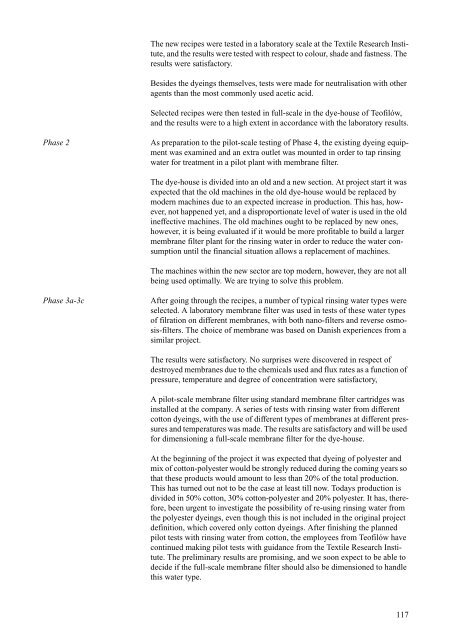Cleaner Technology Transfer to the Polish Textile ... - Miljøstyrelsen
Cleaner Technology Transfer to the Polish Textile ... - Miljøstyrelsen
Cleaner Technology Transfer to the Polish Textile ... - Miljøstyrelsen
You also want an ePaper? Increase the reach of your titles
YUMPU automatically turns print PDFs into web optimized ePapers that Google loves.
The new recipes were tested in a labora<strong>to</strong>ry scale at <strong>the</strong> <strong>Textile</strong> Research Institute,<br />
and <strong>the</strong> results were tested with respect <strong>to</strong> colour, shade and fastness. The<br />
results were satisfac<strong>to</strong>ry.<br />
Besides <strong>the</strong> dyeings <strong>the</strong>mselves, tests were made for neutralisation with o<strong>the</strong>r<br />
agents than <strong>the</strong> most commonly used acetic acid.<br />
Selected recipes were <strong>the</strong>n tested in full-scale in <strong>the</strong> dye-house of Teofilów,<br />
and <strong>the</strong> results were <strong>to</strong> a high extent in accordance with <strong>the</strong> labora<strong>to</strong>ry results.<br />
Phase 2 As preparation <strong>to</strong> <strong>the</strong> pilot-scale testing of Phase 4, <strong>the</strong> existing dyeing equipment<br />
was examined and an extra outlet was mounted in order <strong>to</strong> tap rinsing<br />
water for treatment in a pilot plant with membrane filter.<br />
The dye-house is divided in<strong>to</strong> an old and a new section. At project start it was<br />
expected that <strong>the</strong> old machines in <strong>the</strong> old dye-house would be replaced by<br />
modern machines due <strong>to</strong> an expected increase in production. This has, however,<br />
not happened yet, and a disproportionate level of water is used in <strong>the</strong> old<br />
ineffective machines. The old machines ought <strong>to</strong> be replaced by new ones,<br />
however, it is being evaluated if it would be more profitable <strong>to</strong> build a larger<br />
membrane filter plant for <strong>the</strong> rinsing water in order <strong>to</strong> reduce <strong>the</strong> water consumption<br />
until <strong>the</strong> financial situation allows a replacement of machines.<br />
The machines within <strong>the</strong> new sec<strong>to</strong>r are <strong>to</strong>p modern, however, <strong>the</strong>y are not all<br />
being used optimally. We are trying <strong>to</strong> solve this problem.<br />
Phase 3a-3c After going through <strong>the</strong> recipes, a number of typical rinsing water types were<br />
selected. A labora<strong>to</strong>ry membrane filter was used in tests of <strong>the</strong>se water types<br />
of filration on different membranes, with both nano-filters and reverse osmosis-filters.<br />
The choice of membrane was based on Danish experiences from a<br />
similar project.<br />
The results were satisfac<strong>to</strong>ry. No surprises were discovered in respect of<br />
destroyed membranes due <strong>to</strong> <strong>the</strong> chemicals used and flux rates as a function of<br />
pressure, temperature and degree of concentration were satisfac<strong>to</strong>ry,<br />
A pilot-scale membrane filter using standard membrane filter cartridges was<br />
installed at <strong>the</strong> company. A series of tests with rinsing water from different<br />
cot<strong>to</strong>n dyeings, with <strong>the</strong> use of different types of membranes at different pressures<br />
and temperatures was made. The results are satisfac<strong>to</strong>ry and will be used<br />
for dimensioning a full-scale membrane filter for <strong>the</strong> dye-house.<br />
At <strong>the</strong> beginning of <strong>the</strong> project it was expected that dyeing of polyester and<br />
mix of cot<strong>to</strong>n-polyester would be strongly reduced during <strong>the</strong> coming years so<br />
that <strong>the</strong>se products would amount <strong>to</strong> less than 20% of <strong>the</strong> <strong>to</strong>tal production.<br />
This has turned out not <strong>to</strong> be <strong>the</strong> case at least till now. Todays production is<br />
divided in 50% cot<strong>to</strong>n, 30% cot<strong>to</strong>n-polyester and 20% polyester. It has, <strong>the</strong>refore,<br />
been urgent <strong>to</strong> investigate <strong>the</strong> possibility of re-using rinsing water from<br />
<strong>the</strong> polyester dyeings, even though this is not included in <strong>the</strong> original project<br />
definition, which covered only cot<strong>to</strong>n dyeings. After finishing <strong>the</strong> planned<br />
pilot tests with rinsing water from cot<strong>to</strong>n, <strong>the</strong> employees from Teofilów have<br />
continued making pilot tests with guidance from <strong>the</strong> <strong>Textile</strong> Research Institute.<br />
The preliminary results are promising, and we soon expect <strong>to</strong> be able <strong>to</strong><br />
decide if <strong>the</strong> full-scale membrane filter should also be dimensioned <strong>to</strong> handle<br />
this water type.<br />
117

















